Experimental Study on the Insulation Layer Thickness of a Novel Ice Coring Device in Loose Sandstone-Type Uranium Deposits
Abstract
:1. Introduction
1.1. Background
1.2. Brief Description of the Novel Ice Coring Device
2. Experimental Method
2.1. Materials
2.2. Experimental Setup and Steps
3. Results and Discussions
3.1. Feasibility Analysis of Artificial Samples
3.2. Effect of Insulation Layer Thickness on Freezing Time and the Temperature of Drilling Fluid
3.3. Relationship between the Inner Wall Temperature and Time
3.4. Relationship between Temperature of Center Point and Time
4. Conclusions
Author Contributions
Funding
Data Availability Statement
Conflicts of Interest
References
- Xing, W.L.; Wang, A.J.; Yan, Q.; Chen, S. A study of China’s uranium resources security issues: Based on analysis of China’s nuclear power development trend. Ann. Nucl. Energy 2017, 110, 1156–1164. [Google Scholar] [CrossRef]
- Chen, S.; Xing, W.L.; Du, X.M. Forecast of the demand and supply plan of China’s uranium resources till 2030. Int. J. Green Energy 2017, 14, 638–649. [Google Scholar] [CrossRef]
- Shang, D.L.; Geissler, B.; Mew, M.; Satalkina, L.; Zenk, L.; Tulsidas, H.; Barker, L.; El-Yahyaoui, A.; Hussein, A.; Taha, M.; et al. Unconventional uranium in China’s phosphate rock: Review and outlook. Renew. Sustain. Energy Rev. 2021, 140, 110740. [Google Scholar] [CrossRef]
- Tian, J.L.; Li, J.R.; Cheng, W.M.; Zhu, Z.; Yang, L.; Yang, Y.; Zhang, T.J. Working mechanism and rock-breaking characteristics of coring drill bit. J. Pet. Sci. Eng. 2018, 162, 348–357. [Google Scholar] [CrossRef]
- Belt, J.Q.; Rice, G.K. Application of statistical quality control measures for near-surface geochemical petroleum exploration. Comput. Geosci. 2002, 28, 243–260. [Google Scholar] [CrossRef]
- Xue, Q.L.; Wang, R.H.; Liu, B.L.; Huang, L.L. Dynamic Measurement of Spatial Attitude at Bottom Rotating Drillstring: Simulation, Experimental, and Field Test. J. Energy Resour. Technol. 2016, 138, 022903-1–022903-9. [Google Scholar] [CrossRef]
- Watton, T.J.; Wright, K.A.; Jerram, D.A.; Brown, R.J. The petrophysical and petrographical properties of hyaloclastite deposits: Implications for petroleum exploration. AAPG Bull. 2014, 98, 449–463. [Google Scholar] [CrossRef]
- Zhu, Q.; Yu, R.A.; Feng, X.X.; Li, J.G.; Sima, X.Z.; Tang, C.; Xu, Z.L.; Liu, X.X.; Si, Q.H.; Li, G.Y.; et al. Mineralogy, geochemistry, and fluid action process of uranium deposits in the Zhiluo Formation, Ordos Basin, China. Ore Geol. Rev. 2019, 111, 102984. [Google Scholar] [CrossRef]
- Cai, Y.; Zhang, J.; LI, Z.Y.; Guo, Q.; Song, J.; Fan, H.; Liu, W. Outline of Uranium Resources Characteristics and Metallogenetic Regularity in China. Acta Geol. Sin. 2015, 89, 918–937. [Google Scholar]
- Jin, R.S.; Feng, X.X.; Teng, X.M.; Nie, F.J.; Cao, H.Y.; Hou, H.Q.; Liu, H.X.; Miao, P.S.; Zhao, H.L.; Chen, L.L.; et al. Genesis of green sandstone/mudstone from Middle Jurassic Zhiluo Formation in the Dongsheng Uranium Orefield, Ordos Basin and its enlightenment for uranium mineralization. China Geol. 2020, 3, 52–66. [Google Scholar] [CrossRef]
- Al-Sammak, I.A.; Ahmed, K.; De, S.; Al-Bous, F.; Ahmad, F.; Abbas, F. Coring Unconsolidated Formation-Lower Fars: A Case Study. In Proceedings of the SPE Middle East Oil and Gas Show and Conference, Manama, Bahrain, 15–18 March 2009. [Google Scholar]
- Wang, G.Q.; Xu, H.G.; Wu, L.; Yang, Y. Preparation and Evaluation of Artificial Cores of Unconsolidated Sandstone Considering the Effect of Formation Water. Arab. J. Sci. Eng. 2021, 46, 6809–6815. [Google Scholar] [CrossRef]
- Yan, T.N.; Chen, B.Y.; Shi, Y.Q.; Peng, Z.B.; Wu, L. Geotechnical Drilling Technology; Central South University Press: Changsha, China, 2014. [Google Scholar]
- Kenneth, A.J.; Joseph, B.H. Simple modifications adapt undisturbed samples for sub-surface freezing and recorery of cohesionless soils. World Earthq. Eng. 1983, 3, 75–76. [Google Scholar]
- Li, Y.L.; Peng, J.M.; Huang, C.Y.; Wang, M.S. Experimental study on a sampling technique based on a freeze-sediments valve for deep-sea microorganism. Appl. Ocean. Res. 2019, 82, 470–477. [Google Scholar] [CrossRef]
- Luo, Y.J.; Peng, J.M.; Sun, M.Z.; Sun, Q.; Ji, T.K.; Bo, K. An ice-valve-based pressure-coring system for sampling natural hydrate-bearing sediments: Proof-of-concept laboratory studies. J. Nat. Gas Sci. Eng. 2015, 27, 1462–1469. [Google Scholar] [CrossRef]
- Wu, D.Y.; Peng, J.M.; Sun, M.Z.; Gao, Q.; Zhang, X.X.; Sun, Q.; Bo, K. Experimental study on a pressure-coring technology based on a freeze-core valve for marine hydrate-bearing sediment sampling. J. Nat. Gas Sci. Eng. 2016, 33, 135–142. [Google Scholar] [CrossRef]
- Lian, M.K.; Peng, J.M.; Huang, C.Y.; Li, Y.L.; Zhang, G. Effect of adding brush on the bottom of the ice-valve-sealed pressure-retaining device on ice formation speed. Appl. Therm. Eng. 2021, 184, 116269. [Google Scholar] [CrossRef]
- Dück, Y.; Lorke, A.; Jokiel, C.; Gierse, J. Laboratory and field investigations on freeze and gravity core sampling and assessment of coring disturbances with implications on gas bubble characterization. Limnol. Oceanogr. Methods 2019, 17, 585–606. [Google Scholar] [CrossRef]
- Hao, S.Q.; Kim, S.; Qin, Y.; Fu, X.H. Double protection drilling fluid: Optimization for sandstone-like uranium formation. Appl. Clay Sci. 2014, 88–89, 233–238. [Google Scholar] [CrossRef]
- Xiao, X.J. Study on Geochemistry of Low-Temperature Fluid Mineralization in Sandstone Uranium Deposits in Dongsheng Area; Beijing Research Institute of Uranium Geology: Beijing, China, 2004. [Google Scholar]
- Fischer, R.P.; Chen, Z.S. Prospecting marks of new uranium mining area and ore belt. World Nucl. Geosci. 1975, 4, 37–47. [Google Scholar]
- Jordan, P.; Heb, H. Use of artificial ground freezing in three sections of the Dusseld of subway Ground Freezing. In Proceedings of the Seventh International Symposium on Ground Freezing, Nancy, France, 24–28 October 1994. [Google Scholar]
- Hundy, G.H.; Trott, A.R.; Welch, T.C. Refrigeration and Air Conditioning; McGraw-Hill: New York, NY, USA, 1978. [Google Scholar]
- Heredia-Aricapa, Y.; Belman-Flores, J.M.; Mota-Babiloni, A.; Serrano-Arellano, J.; García-Pabón, J.J. Overview of low GWP mixtures for the replacement of HFC refrigerants: R134a, R404A and R410A. Int. J. Refrig. 2020, 111, 113–123. [Google Scholar] [CrossRef]
- Zhou, Z.F.; Yin, J.; Chen, B.; Liu, B.; Thrassos, P. Liquid phase model and its coupling interaction with the ambient gas for the droplet heating and evaporation of highly volatile R134a. Int. J. Heat Mass Transf. 2021, 166, 120740. [Google Scholar] [CrossRef]
- Yang, W.; Liu, J.P.; Wang, Y.Y.; Gao, S.J. Experimental study on the thermal conductivity of aerogel-enhanced insulating materials under various hygrothermal environments. Energy Build. 2020, 206, 109583. [Google Scholar] [CrossRef]
- Hu, T.F.; Liu, J.K.; Chang, J.; Hao, Z.H. Development of a novel Vapor Compression Refrigeration System (VCRS) for permafrost cooling. Cold Reg. Sci. Technol. 2021, 181, 103173. [Google Scholar] [CrossRef]
- Wang, Q.L.; Li, T.L.; Jia, Y.A.; Zhang, W.M. Thermodynamic performance comparison of series and parallel two-stage evaporation vapor compression refrigeration cycle. Energy Rep. 2021, 7, 1616–1626. [Google Scholar] [CrossRef]
- Incropera, F.P. Fundamentals of Heat and Mass Transfer, 4th ed.; John Wiley & Sons: Hoboken, NJ, USA, 1996. [Google Scholar]
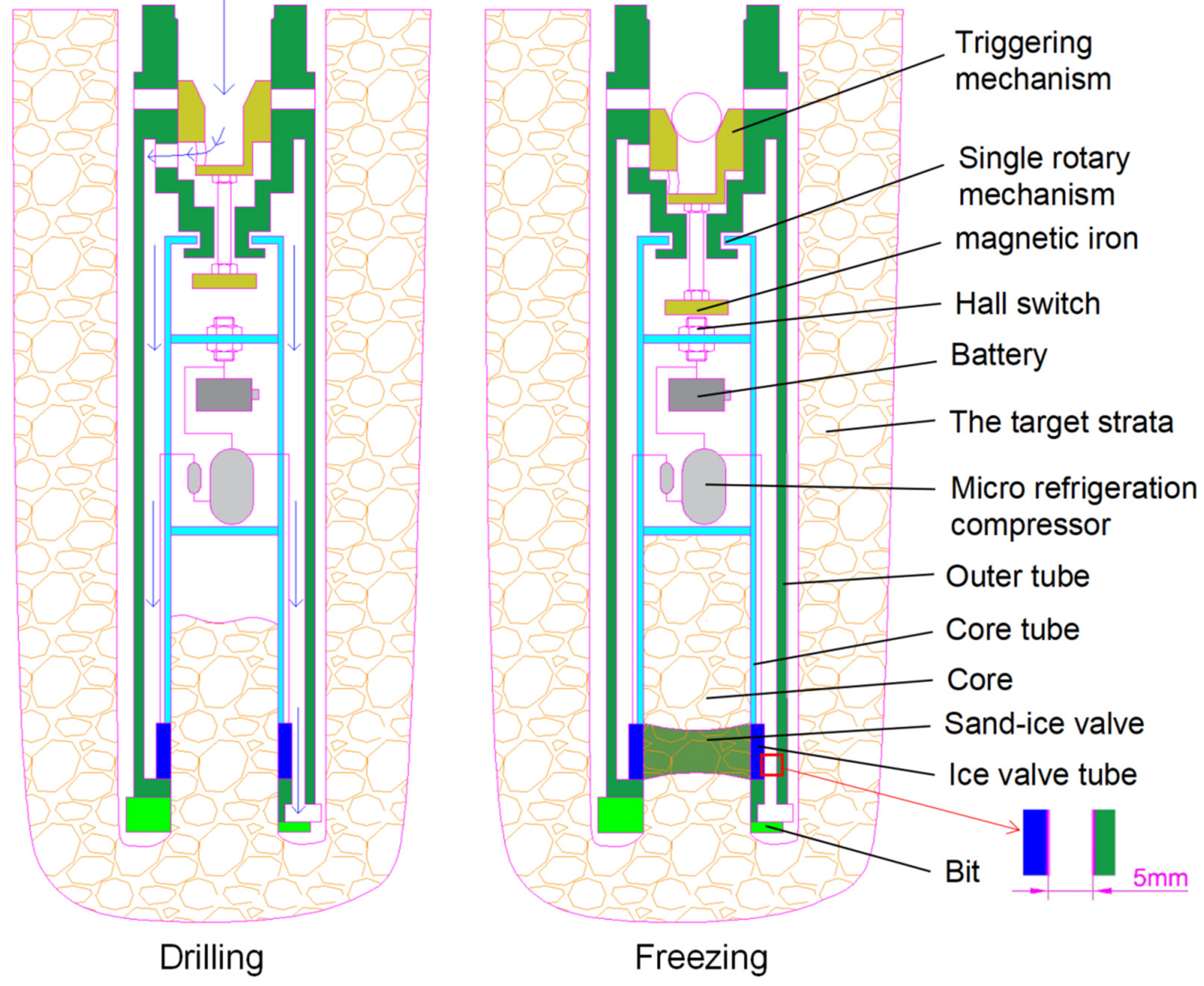

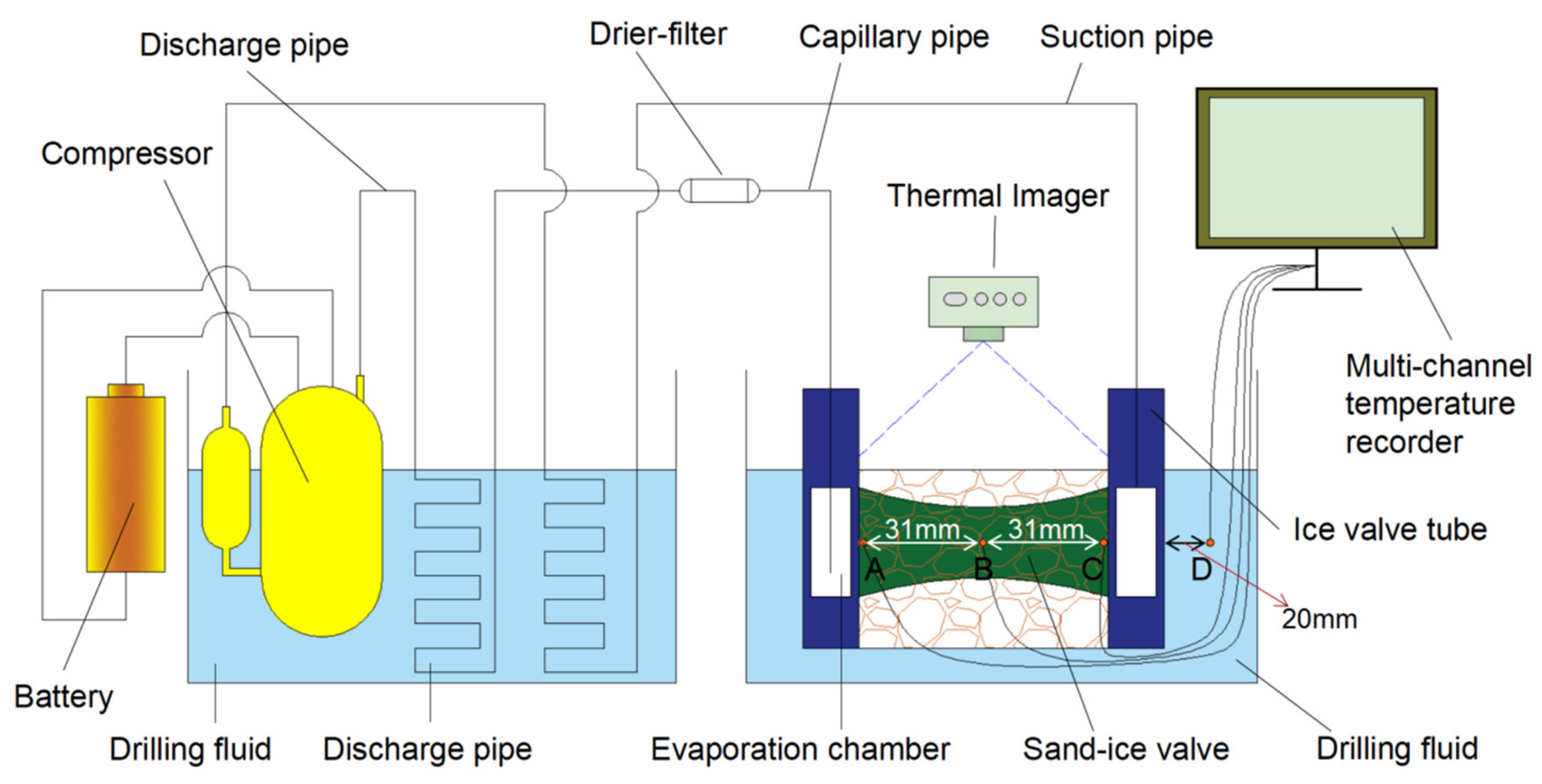
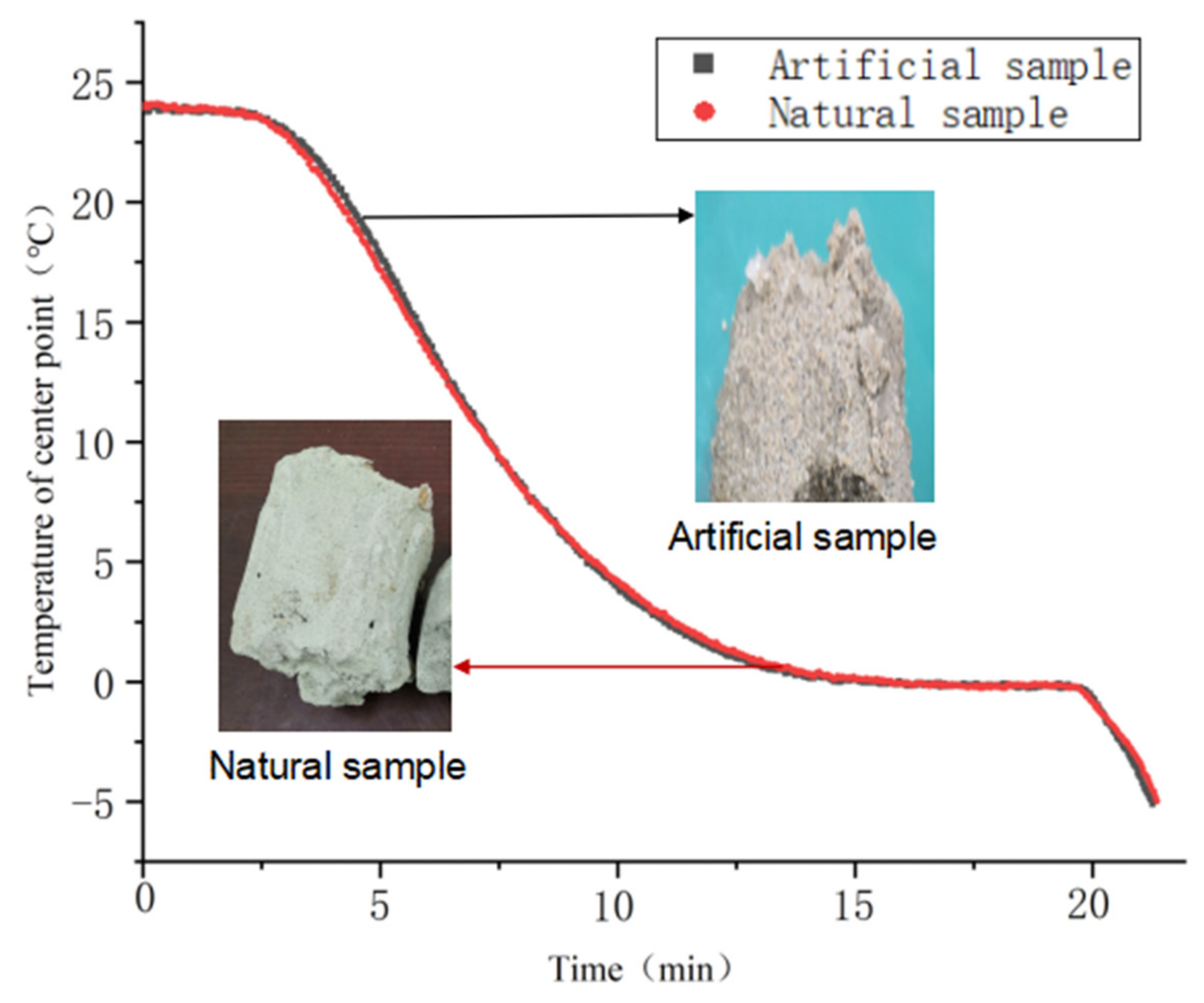
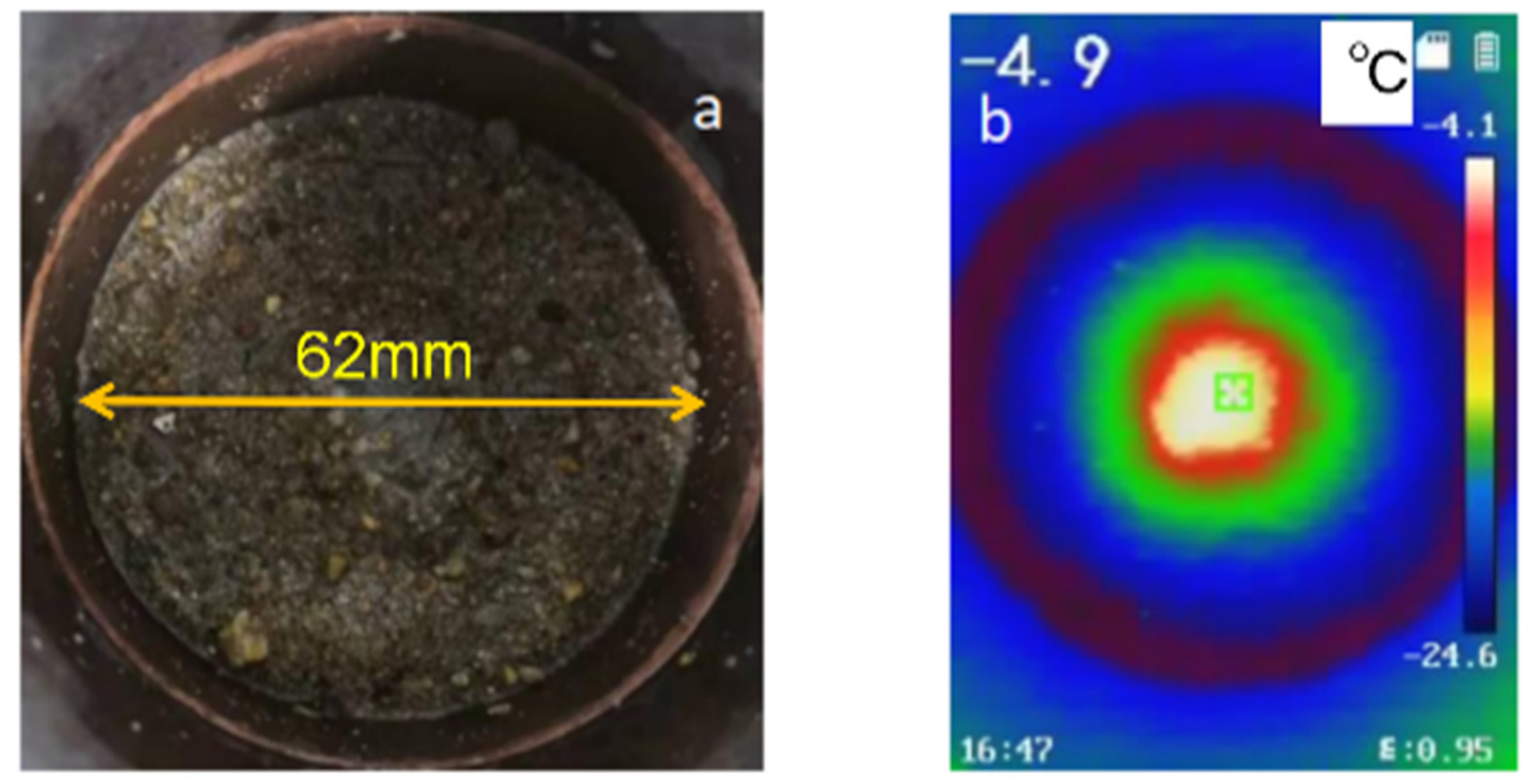
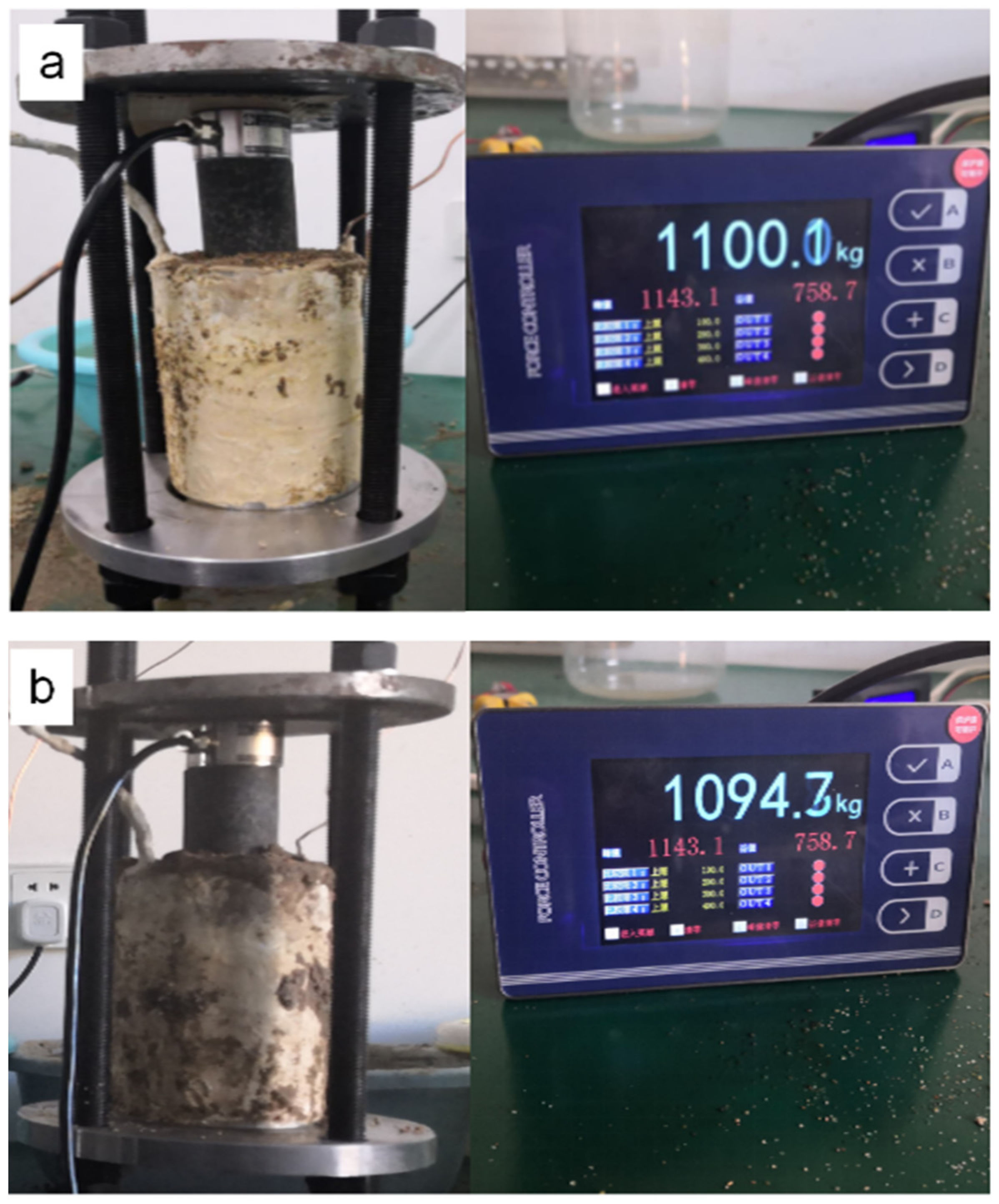
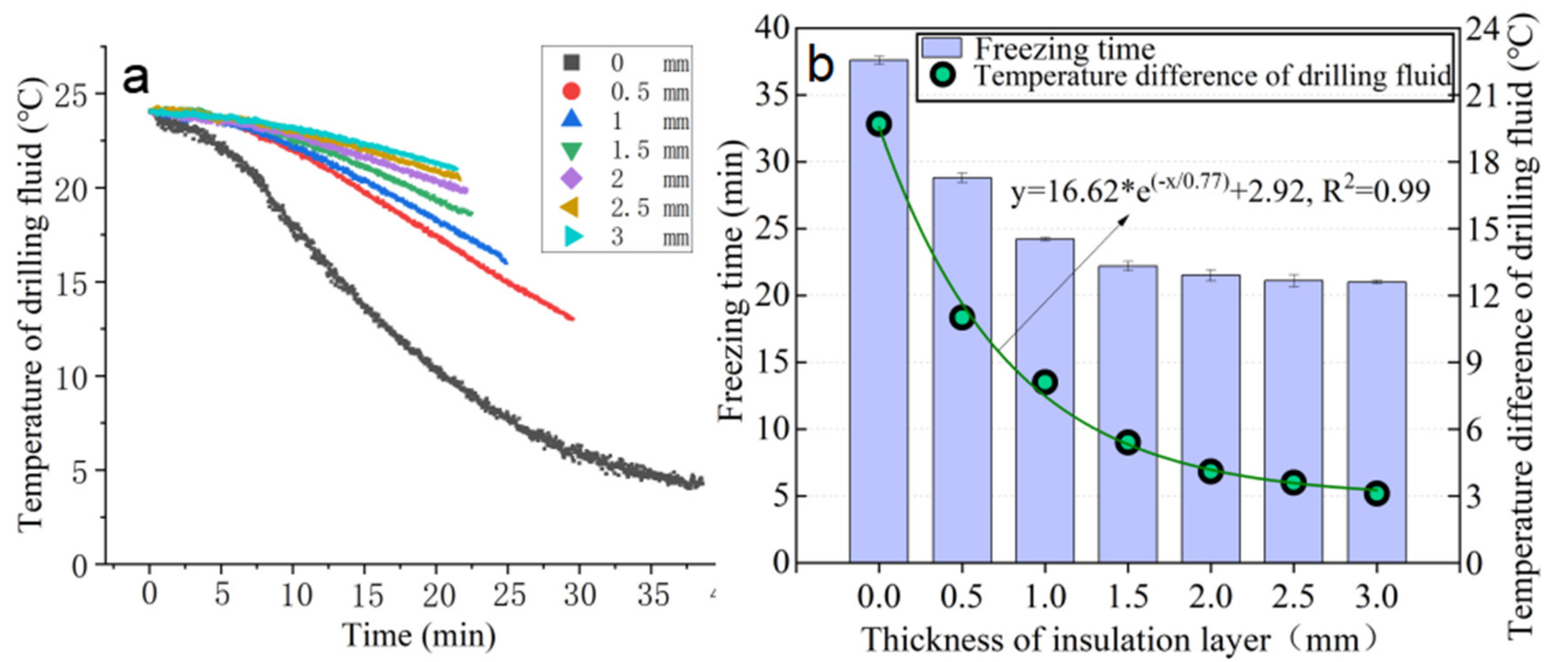
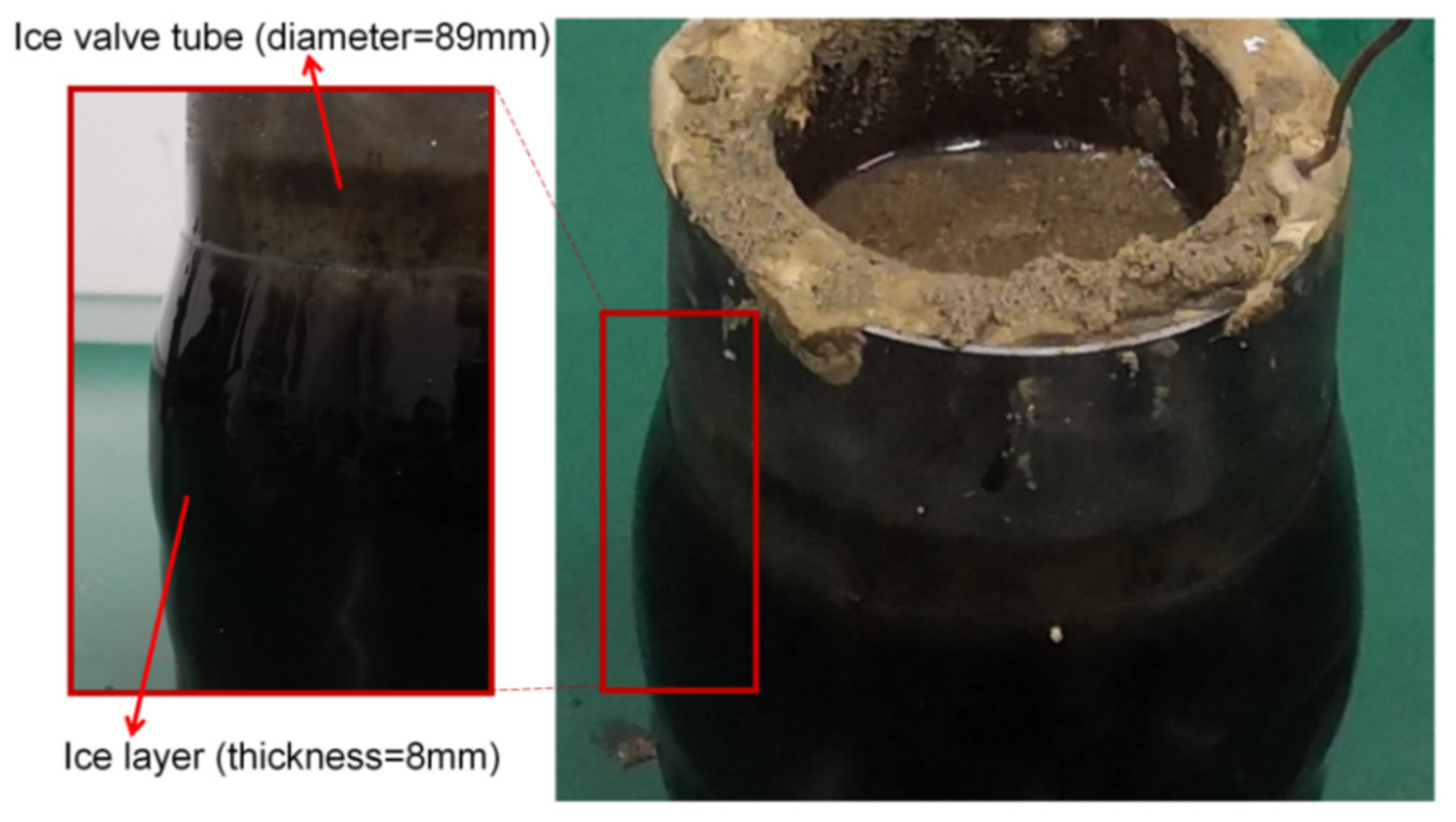
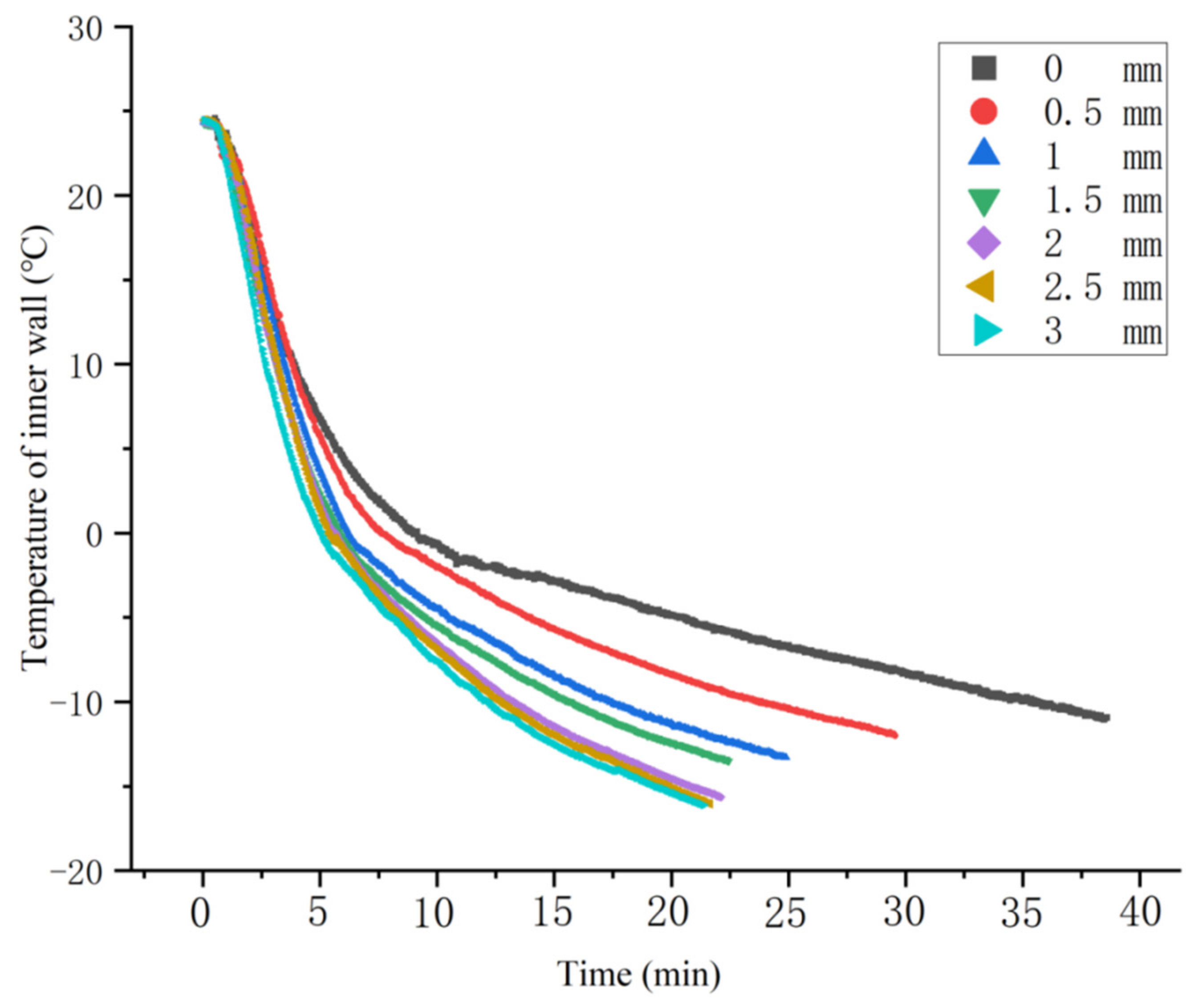
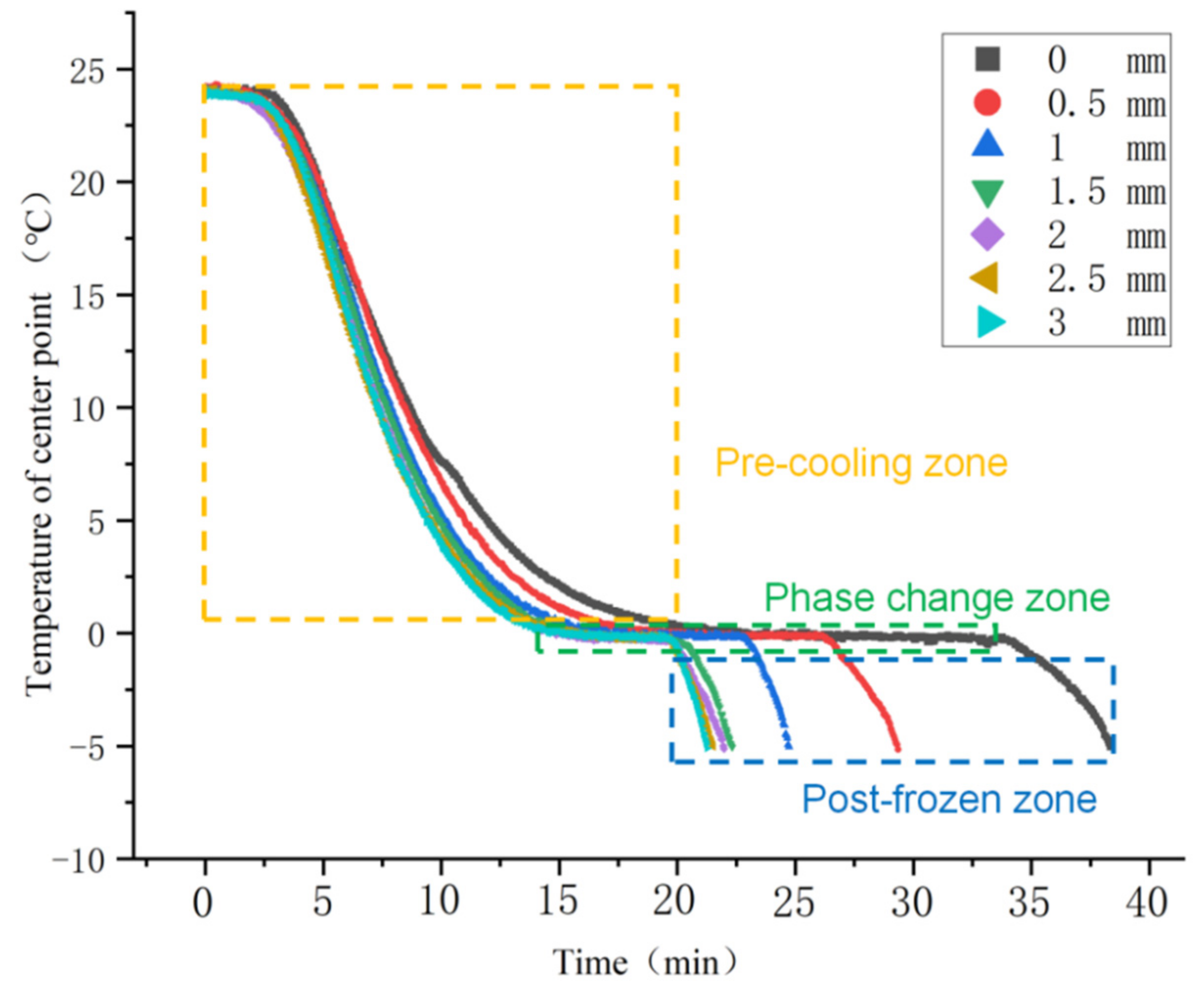
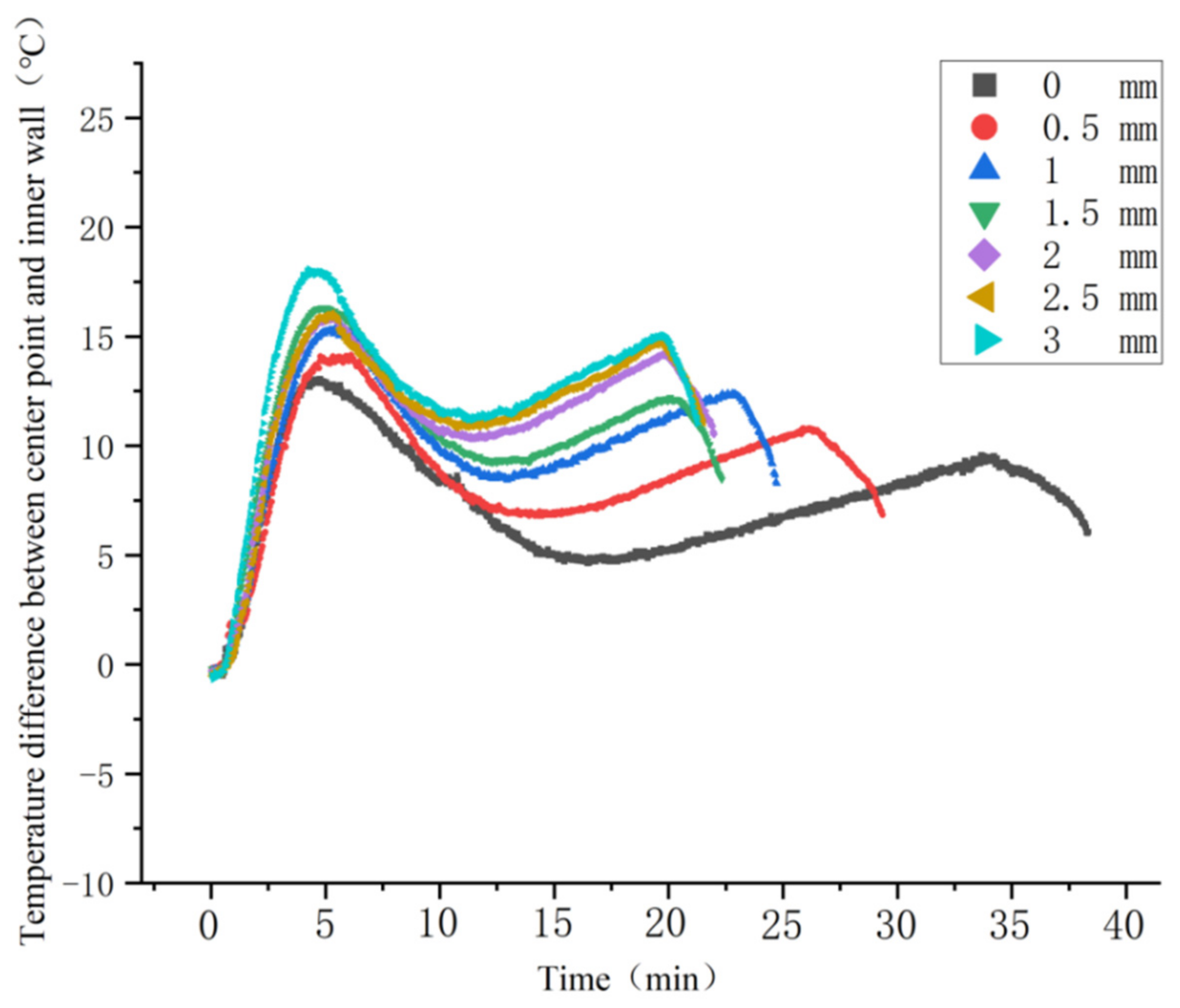
| Type | Features | Picture of Bore Head |
|---|---|---|
| Single tube core barrel | The core can not keep the original shape due to the scour by drilling fluid and the wear between core tube and core. | 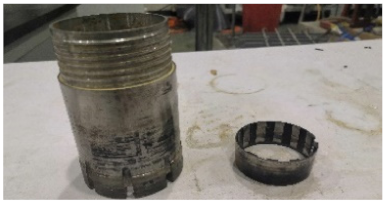 |
| Rigid type double tube core barrel | Rigid type double tube core barrel can prevent the scour of drilling fluid to the core, but it still can not avoid the wear between core tube and core. |  |
| Swivel type double tube core barrel | The swivel type double tube core barrel can not only prevent the scour of drilling fluid to the core, but also avoid the wear between core tube and core. However, there are steps in the bottom of the core tube, which is easy to cause the core to be stuck and blocked. The bottom circlip can not be completely closed, and the core can easily fall off. | 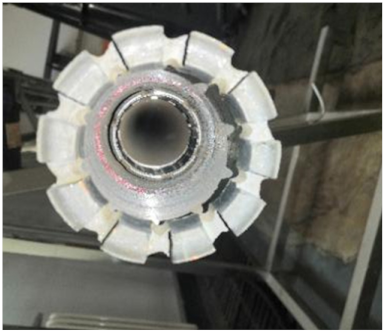 |
| Composition | Component (%) |
|---|---|
| Montmorillonite | 4 |
| Na2CO3 | 1.6 |
| KHM | 0.1 |
| Na-CMC | 1.5 |
| VG | 0.5 |
| Water | 92.3 |
| COMPOSITION | PROPORTION (%) | THE MAIN COMPONENT |
|---|---|---|
| CLASTIC | 80% | Quartz (40~65%), Feldspar (15~35%) |
| CEMENT | 10% | Silty and muddy |
| MISCELLANEOUS | 10% | Clayey with pore type cement |
| Model | IST BX25-DC24E |
|---|---|
| Compression type | Fully enclosed rotary DC compressor |
| Gas displacement | 2.5 cc/rev |
| Rated refrigerating capacity | 175 w–500 w |
| Rated input power | 70 w–160 w |
| Power | DC 24 V |
| Rated current | 5.5 A |
| Compressor dimensions | Height: 115 mm; diameter: 60 mm |
Publisher’s Note: MDPI stays neutral with regard to jurisdictional claims in published maps and institutional affiliations. |
© 2021 by the authors. Licensee MDPI, Basel, Switzerland. This article is an open access article distributed under the terms and conditions of the Creative Commons Attribution (CC BY) license (https://creativecommons.org/licenses/by/4.0/).
Share and Cite
Huang, C.; Peng, J.; Li, Y.; Lian, M.; Guo, C.; Luo, Y.; Bo, K. Experimental Study on the Insulation Layer Thickness of a Novel Ice Coring Device in Loose Sandstone-Type Uranium Deposits. Energies 2021, 14, 7448. https://doi.org/10.3390/en14217448
Huang C, Peng J, Li Y, Lian M, Guo C, Luo Y, Bo K. Experimental Study on the Insulation Layer Thickness of a Novel Ice Coring Device in Loose Sandstone-Type Uranium Deposits. Energies. 2021; 14(21):7448. https://doi.org/10.3390/en14217448
Chicago/Turabian StyleHuang, Chaoyang, Jianming Peng, Yanliang Li, Moke Lian, Chao Guo, Yongjiang Luo, and Kun Bo. 2021. "Experimental Study on the Insulation Layer Thickness of a Novel Ice Coring Device in Loose Sandstone-Type Uranium Deposits" Energies 14, no. 21: 7448. https://doi.org/10.3390/en14217448
APA StyleHuang, C., Peng, J., Li, Y., Lian, M., Guo, C., Luo, Y., & Bo, K. (2021). Experimental Study on the Insulation Layer Thickness of a Novel Ice Coring Device in Loose Sandstone-Type Uranium Deposits. Energies, 14(21), 7448. https://doi.org/10.3390/en14217448






